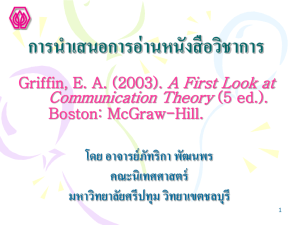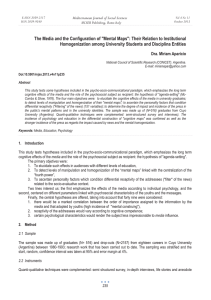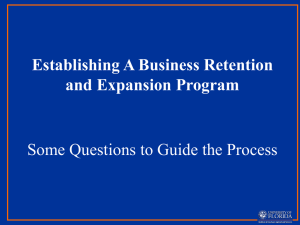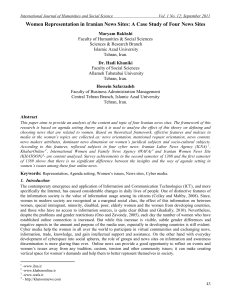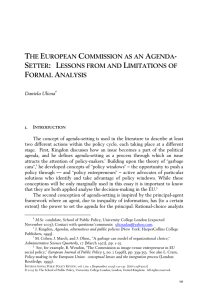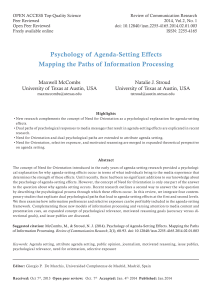- Governance Assessment Portal
advertisement
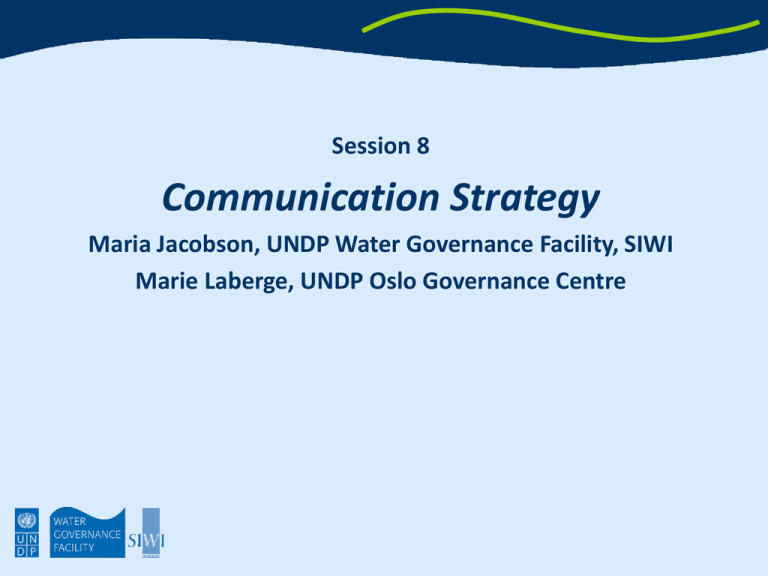
Session 8 Communication Strategy Maria Jacobson, UNDP Water Governance Facility, SIWI Marie Laberge, UNDP Oslo Governance Centre Outline Why should a communication strategy be planned systematically? What are four basic steps of the communication planning cycle? What are the relationships between: 1) a policy agenda (what needs to change) 2) the communication agenda (how to influence change) and 3) the action plan (activities to support the communication agenda) Why should a communication strategy be planned systematically? • Need to go beyond awareness-raising – Using communication to influence policy and practice of institutions • For communication to be effective: – Identify what needs to change (evidence-based) – Fully understand the processes by which change can take place (evidence-based) • Need to reflect the specific location and context • A ‘misguided’ communication strategy can backfire... What are four basic steps of the communication planning cycle? 1. Decision-making: Commitment-making and organising a management plan to implement a communications strategy 2. Policy-agenda setting: Identifying targeted changes – aims and objectives 3. Communication-agenda setting: Determining how best to influence change – influencing strategy, concerned audiences and tactics 4. Action planning: Identifying activities to engage different decision-makers, influentials and concerned audiences Stage 1 – Decision-making • Reach an agreement on how decisions will be made: – By the research Group ? The Advisory Group? – Or establish a separate Communication Task Force, constituted by communication stakeholders? – Nominate a ‘spokesperson’? • Ensure broad-based ownership & participation in the implementation of the communication strategy Stage 2 – Policy Agenda-Setting: Identifying what should change • What is the critical element we want to change to improve water integrity? – Are we after a change in the law (if so, which law)? – Do we want increased transparency in procurement processes (if so, how can this be done)? – Or do we merely want a change in the actions of officials running the processes? • Have we properly understood the reasons why corruption has become rampant? Have we identified where responsibility has failed? • Do we have a common voice when it comes to suggesting alternative ways of doing things? Stage 2 – Policy Agenda-Setting: Identifying what should change • The focus should be limited to 1 or 2 of the most important recommendations (to ensure highest impact of communications resources) • Communication objectives should be SMART: – Specific, Measurable, Achievable, Relevant and Time bound. • Objectives should specify the outcome being sought, not the activity propose. Stage 2 – Policy Agenda-Setting: Identifying what should change Not SMART communication objective SMART communication objective Why is it SMART To eliminate corruption in procurement processes in the water sector. To convince the Ministry of Water and Ministry of Finance to adopt Integrity Pacts in the bidding processes for all major water infrastructure projects starting in 2010. Specific: will be measured by whether or not Integrity Pacts are adopted. But would be more specific if the persons to be convinced in the 2 ministries had been identified, and if what is meant by a ‘major’ (infrastructure) project had been defined. There is a time frame – 2010. Stage 2 – Policy Agenda-Setting: Identifying what should change – Example 2 Not SMART communication objective To change the corrupt behaviour of water officials. SMART communication objective Why is it SMART To collect 5 human interest stories about corruption victims and publish them through mainstream media channels within the next 6 months to make known the negative effects of corruption on the poor and appeal to people’s ethical behaviours. Specific – it has a concrete number of stories to be collected. Measurable – the goal is to have at least x newspapers and TV broadcasts report your stories. Achievable – collecting interviews, writing stories and media dissemination is possible within a reasonable budget. Relevant – it will raise attention to a wide public audience. Timebound – it should happen within the next 6 months. Stage 3 – Communication Agenda-Setting: Determining how to best influence change • • Identify what ‘channels of influence’ to use – which concerned audiences or ‘influentials’ to communicate with in order to put pressure on the policy-makers to take action. To develop an ‘influencing strategy’: – A) Understand the policy-making process: draw a flowchart setting out all the stages of the policy-making process and identifying the people or institutions involved at every stage – B) Pinpoint the ‘decision-maker’: what to do to reach them, how to engage with them, what specialised materials need to be prepared for them, what tone or approach to use in a face-to-face meeting with them – C) Understand the advocacy environment: list all the relevant factors that may affect advocacy on water corruption Stage 3 – Communication Agenda-Setting: Determining how to best influence change To develop an ‘influencing strategy’ (continued): • • • • • D) Assess your advocacy capacity: Perform an honest assessment of the resources available for undertaking a communication strategy (funding sources, staff & their skills, reputation of an organisation) E) Understand the various stakeholders (the people or groups affected by the issue or who can influence the outcome): will they be for or against the objectives, or neutral? F) Make choices: Choose what approach to take and which stakeholders will be the channels of influence. With a focus on a few targets, there is a greater chance of making a breakthrough. G) Determine messages and tactics: Brief & concise H) Tailor your communications for the receivers of the message: Are they the decision-makers? Are they ‘influentials’ or opinion-shapers? Are they concerned audiences? Are they media organisations? Stage 3 – Communication Agenda-Setting: Determining how to best influence change Targets Tailor your communications Policymakers and opinion shapers Need detailed messages supported by rational arguments based on good evidence. Communication with this group should be personalised – letters, phone calls, meetings, etc. Public audiences Use simple messages presented in an interesting and emotive way. Be creative. Apart from using the media, use posters, brochures, open meetings, street theatre and other events. The media The aim is to achieve more than a small article about a workshop or seminar. In-depth coverage in newspapers and magazines can result from encouraging journalists to write articles examining water corruption. Indepth coverage on radio and TV may come from persuading journalists to do investigations, but you can also obtain good results from live debates, interviews and phone-in shows. Stage 4 – Action Planning Objective 1 Activities (with dates) Targets & influentials Indicators of progress People responsible Review (with dates) Objective 2 Objective 3 Some media issues in water integrity advocacy The media can be a ‘double-edged sword’ for anticorruption reform The media can play an important role in building awareness and shaping public opinion But in many cases the media tend to sensationalise individual cases rather than focus attention on the issues that breed corruption & the changes that are really needed A debate in the ‘court of public opinion’ may make the government more defensive rather than open about changing policy A low-key visit to the policy-maker’s office to quietly present analysis and put forward proposals can be a more time- and resource efficient way of getting the change you want Never go the media with unverified claims: You risk destroying your own reputation The media tends to prefer real ‘stories’ they think will interest the public The Yemen case National Communication & Awareness Strategy for IWRM Developed by the National Water Resources Authority of Yemen 1) Selecting relevant awareness messages Problem-based analysis: Listing the main water problems, their causes, possible solutions and awareness messages derived from this analysis Example: ‘Groundwater depletion’ 2) Identifying communication ‘targets’, the means of reaching the targets (‘communication tools’) and specific activities Here, the messages conveyed in the problem-based analysis are grouped in around key objectives for the communication strategy Example: Objective 4 – ‘Control the extraction and use of water resources’ The Macedonian case Manual for administrative procedures in municipalities Developed by the Association of Local Governments of Macedonia Decentralization resulted in unequal application of administrative procedures in various municipalities Assessment methodology served to identify integrity risks at municipal level in areas of urban planning, procurement, and public financial management Based on assessment findings, a Manual written in user-friendly language was published: • To explain citizens in simple terms how to access public services, in a step-by step format • To promote a more uniform provision of services by civil servants across the country, by providing a compendium describing the procedures which should be applied nationwide Planning ahead: Implications for the communication of the Tajik assessment?
